NTN Satellite courses are designed to provide learners with a deep understanding of satellite technology and its applications in the telecommunications industry. This course covers a wide range of topics related to satellite communication, including satellite design, operation, maintenance, and troubleshooting.
The NTN Satellite courses are ideal for professionals working in the telecommunications field who are looking to expand their knowledge and skills in satellite technology. Whether you are a network engineer, system administrator, or telecommunications manager, this course will provide you with the expertise needed to effectively design, implement, and manage satellite communication systems.
Throughout the courses, learners will have access to a variety of resources, including interactive modules, video lectures, case studies, and hands-on exercises. These resources are designed to help learners grasp complex concepts and apply them in real-world scenarios. Additionally, the course includes assessments and quizzes to test learners' understanding of the material and track their progress.
By completing the NTN Satellite courses, learners will gain a solid foundation in satellite technology and be equipped with the skills needed to excel in their careers. This course is also beneficial for organizations looking to train their employees in satellite communication, as it provides a cost-effective and flexible training solution.
NTN/Satellite Communications Training Courses
-

Satellite and Non-Terrestrial Communications in the 5G+ Era
This program explores modern satellite communications and Non-Terrestrial Networks (NTN). It covers key principles, challenges, and technical limitations, including a look at different satellite orbits, as well as HAPS, HIBS, balloons, and drones. The program then explores key use cases and their suitability for satellite and NTN. It surveys existing and emerging proprietary satellite systems and focuses on integrating 5G satellite systems into modern networks. The program also covers different architectures, access technologies (5G New Radio, NB-IoT, and eMTC), and Direct-to-Device (D2D) services. Finally, it explores key challenges and their standardized (3GPP) solutions, such as doppler compensation, latency, and security. Who Would Benefit? This course caters to telecom professionals, engineers, and decision-makers seeking a foundational understanding - ideal for those involved in network planning, technology strategy, and service development. Prerequisites A foundational knowledge of telecommunications would be beneficial. Some familiarity with 5G technology and networking principles will also enhance comprehension. Course Contents Introduction to Satellite Communication Introduction to Non-Terrestrial Networks (NTN) Market and Technology Development 5G Satellite – Deployment and Operational Requirements 5G Satellite Integration and Architectures Key Deployment Challenges and Standardised Solutions
£1,815.00
-

Approaches to Satellite Compatibility (LS telcom)
ntn The increase in new Low Earth Orbit satellite constellations has resulted in a surge of compatibility studies being carried out to understand how Non-Geosynchronous Orbit (NGSO) and Geosynchronous Orbit satellites (GSO) can coexist. The issue has arisen from the demand in new high speed broadband services but also the cost of producing and launching satellites into orbit reducing greatly in recent years. There are many complexities in solving the compatibility between NGSO and GSO systems due to the muti-dimensional and highly dynamic nature of both systems. We will focus on the main technical parameters and calculations that are used to determine the unacceptable levels of interference. The course will look across the different services including MSS, FSS (BSS) but also protection of EESS in a range of frequency bands. This course will also touch upon the two approaches to Direct to Device services. This is the use of Mobile Satellite Service spectrum but also Mobile Service spectrum bands. We will cover the implications and challenges of adopting each approach and how regulations will need to evolve to support these approaches. Course Objectives After completing the course, participants will be aware of the technical complexities of conducting compatibility studies that take place within the ITU. It will provide participants with the knowledge of the main technical parameters and calculations needed to determine interference levels. Participants will have an understanding how NGSO and GSO will be able to coexist. Intended for people working at regulators, satellite operators and vendors with some technical knowledge of satellite technologies and radio regulations and some knowledge of the ITU-R processes. The course is also suitable for non-technical people within government departments and ministries who wish to understand all the relevant complexities of compatibility studies and processes for updating the regulations. Contents Introduction to satellite technologies and deployments including definition of GSO and NGSO satellites Technical parameters used for compatibility studies Analysis of interference calculations for compatibility Overview of ITU working party study practices and example compatibility exercise Basic interference and compatibility calculations Overview of D2D spectrum approaches About LS telcom: LS telcom is a global leader in technologies and consulting services for efficient radio spectrum use, optimizing spectrum management to ensure reliable, interference-free, and secure radio services. Our portfolio includes consulting, measurement services, and integrated solutions for planning, analysis, monitoring, and managing radio infrastructure. Serving customers in over 100 countries, including regulatory authorities, network operators, and industries such as transport, utilities, and security, LS telcom operates globally with subsidiaries and offices in locations like Germany, the UK, Canada, India, and the UAE. Headquartered in Lichtenau, Germany, LS telcom AG has been listed on the German Stock Exchange since 2001 (ISIN DE 0005754402).
£1,300.00
-
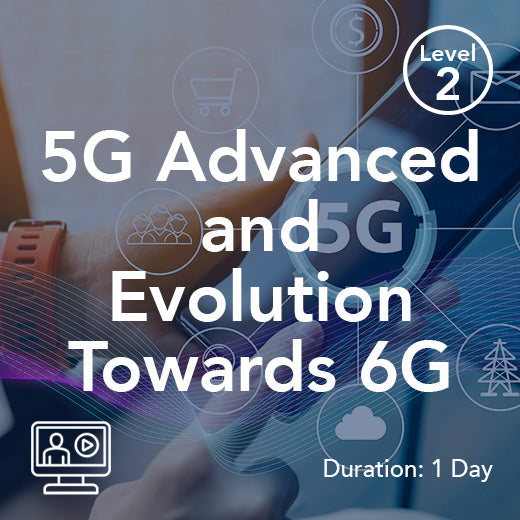
5G Advanced and Evolution Towards 6G
This 5G Advanced and Evolution Towards 6G course delves into 5G Advanced and its role as a stepping stone to the groundbreaking 6G era. You'll explore how 5G is being enhanced to deliver even higher speeds, lower latency, and greater capacity. We'll dissect key features and advancements that are laying the groundwork for the future of connectivity. Beyond 5G, the course will provide a glimpse into the potential of 6G, examining emerging technologies and their implications for industries and society. The course provides a holistic overview of the current (relatively early) state of play of 6G development. We develop crucial insights into 6G design, performance objectives, and its intersection with the metaverse and AI, ensuring participants are well-prepared for the future of wireless communication. By the end of this course, you'll gain a comprehensive understanding of the latestdevelopments in mobile network technology and the exciting possibilities they hold. Who Would Benefit Although this course is open to all, it is recommended that you have prior experience in telecommunications. Course Contents 5G Advanced - Base Capabilities Improvements Specific 5G Advanced Features 6G – a Look Ahead
£980.00
-
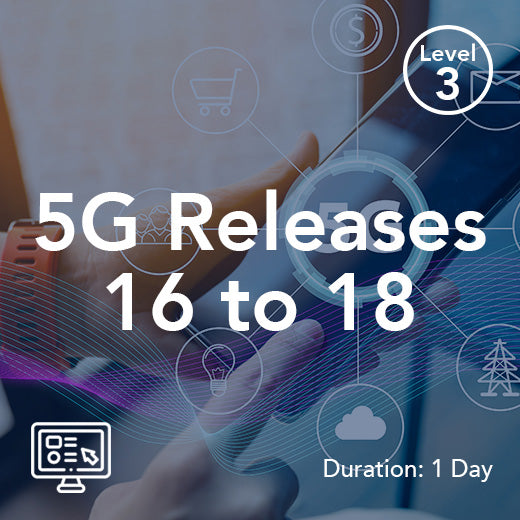
5G Releases 16 to 18
This 1/2-day course provides an overview of the latest advancements in 5G technology, specifically focusing on Releases 16, 17, and 18. Participants will gain insight into the enhanced capabilities of 5G and 5G-Advanced, covering topics such as Vehicle-to-Everything (V2X) services, Integrated Access and Backhaul (IAB), Non-Terrestrial Networks (NTNs), Machine Type Communications (MTC), and the Industrial Internet of Things (IIoT). This course is designed to keep engineers up-to-date with the evolving landscape of 5G technology. Engineers looking to expand their knowledge and understanding of 5G technology would greatly benefit from this course. It is ideal for individuals who are already familiar with mobile telecommunication systems and have a basic understanding of 5G Release 15. By completing this course, participants will be equipped with the necessary knowledge to navigate the complexities of 5G technology and stay ahead in this rapidly evolving industry. Who would benefit The course is intended for engineers who require an up-to-date knowledge of the capabilities of 5G. Prerequisites The course assumes familiarity with mobile telecommunication systems and a basic understanding of 5G Release 15.
POA: Private Course
-
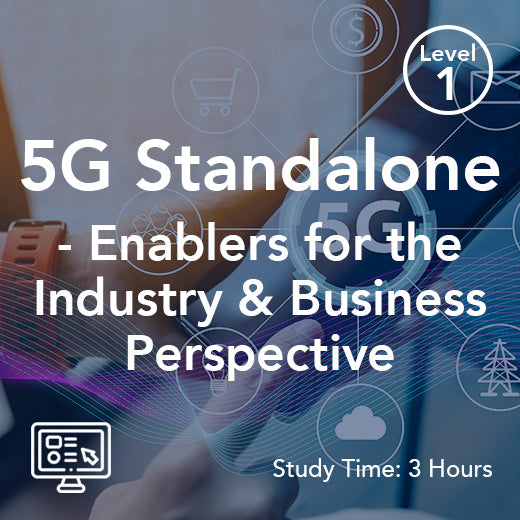
5G – Standalone, Enablers for the Industry & Business Perspective (On-Demand)
With SA 5G, we witness the evolution of mobile networks, from being reliant on legacy infrastructure, to achieving true independence - and unlocking unprecedented capabilities that enables 5G to support a much wider range of industrial use cases. In this course, we guide you through the benefits and challenges of deploying Standalone 5G, exploring its architectural advancements, unique features, and the benefits it brings to both consumers and businesses. We then highlight the enhanced capabilities and expanded use cases made possible by key technology enablers - including network slicing, edge computing, virtualization, non-terrestrial networks (NTNs), network exposure, and network automation. We discuss the impact of 5G SA for network operators, service providers, and enterprises - exploring the opportunities and challenges that arise in the deployment and management of advanced 5G networks. Who Would Benefit Ideal for anyone needing clarity on 5G trajectory – including capabilities & use cases Prerequisites A basic appreciation of the telecoms landscape – both technical and business Course Contents 5G Base Capabilities A Business Perspective 5G Standalone (SA) 5G Enablers for Industry
£95.00
-

5G/6G Essential Protocols and Procedures (Training & IEEE Innovation Testbed)
Transformative Training Powered by IEEE and Wray Castle Powered by the joint expertise of IEEE and Wray Castle, the 5G/6G Essential Protocols & Procedures Training and Innovation Testbed offers a comprehensive exploration of 5G’s most crucial protocols and procedures. This cutting-edge course blends robust theory with hands-on practice via the IEEE 5G/6G Innovation Testbed - a secure, cloud-based platform providing end-to-end 5G network testing capabilities. The Key Protocols & Procedures Putting Theory Immediately into Practice 5G Registration Process - Identities, Authentication, Subscriber Data Network Functions & Interactions - UDM, UDR, PCF, AMF, SMF, UPF PDU Session Establishment - End-to-End signaling and network slicing PFCP & N4 Signaling -Policy and Session Management in 5G Specifically designed for: System engineers and integrators Engineers working with operation, optimization, and troubleshooting Technical professionals responsible for 5G System signaling
£1,045.00
-
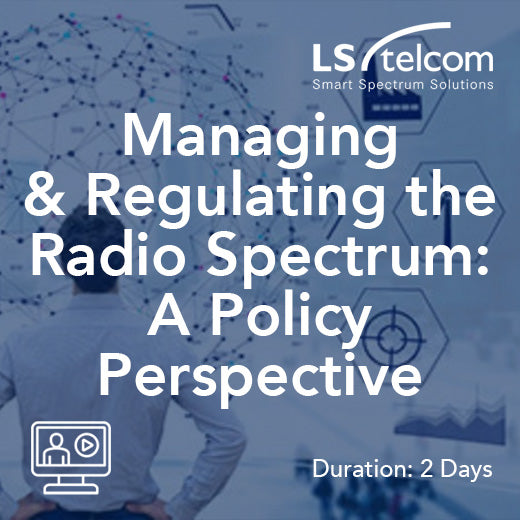
Managing and Regulating the Radio Spectrum: A Policy Perspective (LS telcom)
The radio spectrum is a limited resource that has to be shared between different services, technologies, users and countries. It is the task of regulatory authorities to manage the resource and to optimize its use. International frameworks provide the basis for spectrum management, however knowledge of the characteristics of the radio spectrum and technologies that use it are necessary for these frameworks to be translated into realizable policies and practices at a national and regional level. This course provides an overview of the goals of spectrum management as well as delivering an understanding of the specific characteristics of different parts of the radio spectrum and how this impacts its utility and value. The use of different spectrum bands is discussed, together with a consideration of the way in which historic and new radio technologies use spectrum and the techniques being considered to maximize efficiency and sharing. Different facets of spectrum management and regulation are explained. The course explores assignment and planning methods from the classical command and control techniques to developments in economic techniques such as pricing, trading and auctions. It takes a look at techniques such as spectrum sharing and dynamic access and licensed shared access to help understand what failings of existing techniques they are seeking to redress. Course Objectives After completion of the course, participants will understand how the radio spectrum is used, and approaches to its management and regulation with respect to setting certain policies. They will have extended their knowledge of spectrum management and will have been updated on the latest techniques and processes being employed. Intended for This course is ideal for those working in a policy development and technical/non-technical positions within a spectrum regulator or regulatory body. It is useful for those who wish to deepen their knowledge of the toolkit for spectrum regulation and management including consultants, investors, manufacturers, major spectrum users and those for whom managing the spectrum is a part of their daily job. Contents Characteristics of radio spectrum and radio technologies The international framework and processes for spectrum management Translating spectrum characteristics into policy levers Evolution of spectrum assignment approaches Spectrum sharing; a paradigm to innovative spectrum management About LS telcom: LS telcom is a global leader in technologies and consulting services for efficient radio spectrum use, optimizing spectrum management to ensure reliable, interference-free, and secure radio services. Our portfolio includes consulting, measurement services, and integrated solutions for planning, analysis, monitoring, and managing radio infrastructure. Serving customers in over 100 countries, including regulatory authorities, network operators, and industries such as transport, utilities, and security, LS telcom operates globally with subsidiaries and offices in locations like Germany, the UK, Canada, India, and the UAE. Headquartered in Lichtenau, Germany, LS telcom AG has been listed on the German Stock Exchange since 2001 (ISIN DE 0005754402).
£1,300.00
-
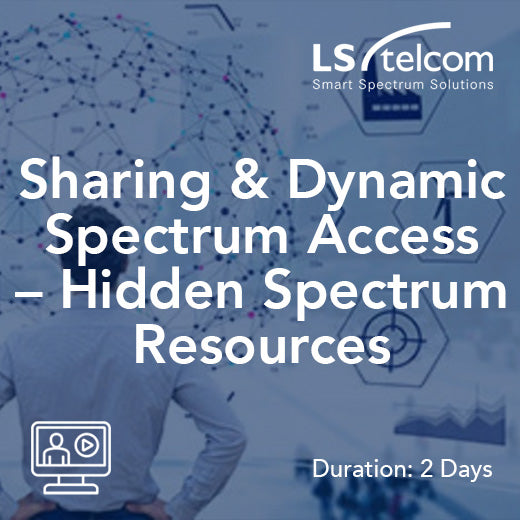
Sharing and Dynamic Spectrum Access – Hidden Spectrum Resources (LS telcom)
The planning rules for radio services often leave small gaps which cannot be used or the scattered use of spectrum by a primary user leaves larger opportunities. Such spectrum might be accessible for different or additional radio services, typically ones with very low power which will not cause undue interference to the primary users. These opportunities were referred to as ‘whitespaces’ but the focus more recently considers methods such as dynamic spectrum assignment. In addition, regulatory techniques are trying to find ways to make sharing spectrum a more common practice for use across a myriad of spectrum services. This course examines the background to whitespaces, considering how and where they arise and looks at a range of sharing opportunities. It then focuses on how spectrum might be made available to additional parties, and what kind of communications it might support. Finally, the various regulatory methods and technologies (including DSA/LSA and the role of databases) being considered will be examined. Course Objectives After completing the course, delegates will understand the history of whitespaces, and the more recent opportunities for sharing together with methods to regulate usage. Current developments and case studies will also be provided. Intended for those who need to understand the regulation and practical application of advanced sharing techniques, whether from a regulatory or commercial perspective. Contents The possible applications for more advanced spectrum sharing methods Technologies being developed for the exploitation spectrum sharing Where are there opportunities for more advanced sharing? How is interference dealt with The regulatory processes and procedures being applied Geographic databases and dynamic spectrum access Licensed shared access and similar regulatory tools About LS telcom: LS telcom is a global leader in technologies and consulting services for efficient radio spectrum use, optimizing spectrum management to ensure reliable, interference-free, and secure radio services. Our portfolio includes consulting, measurement services, and integrated solutions for planning, analysis, monitoring, and managing radio infrastructure. Serving customers in over 100 countries, including regulatory authorities, network operators, and industries such as transport, utilities, and security, LS telcom operates globally with subsidiaries and offices in locations like Germany, the UK, Canada, India, and the UAE. Headquartered in Lichtenau, Germany, LS telcom AG has been listed on the German Stock Exchange since 2001 (ISIN DE 0005754402).
£1,300.00
-
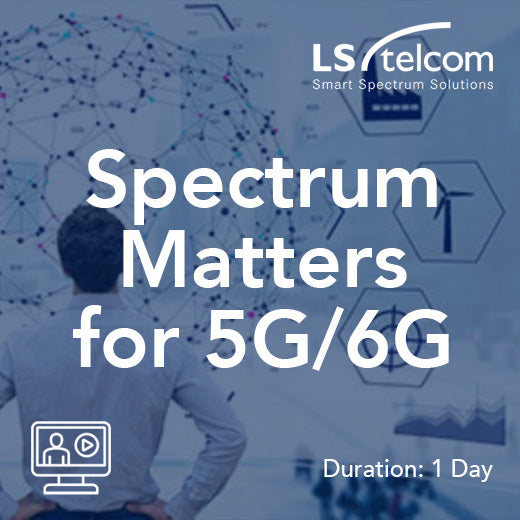
Spectrum Matters for 5G/6G (LS telcom)
5G is driven both by the need for mobile operators to continuously strive to satisfy the growing and unquestionable demand for mobile data, and to support new use cases and services. Regulators and governments have been involved in establishing policies and approaches to award spectrum, so that new 5G services can be rolled out to consumers, enterprises, public sector and government agencies alike. Questions remain about how much more spectrum is needed for 5G but also for what spectrum is needed for 6G which is due for commercialization in the early 2030’s. When it comes to the question of spectrum however, there are many different views about how growth in data traffic impacts upon demand for radio spectrum. It is also evident that below 6 GHz there is very little spectrum remaining that can be re-farmed for mobile services and much of the focus for new spectrum for future mobile (6G) services is concentrated above 6 GHz. How feasible is it to deliver mobile services at such high frequencies? Are there ways to use existing spectrum more efficiently, or are technologies such as LTE and 5G Advanced already very close to the limit of what is achievable? Course Objectives After completing the course, participants will have an understanding of how the evolution towards new standard cellular technologies 5G and 6G has meant identifying new spectrum, or at least one new band. Participants will also understand the practical utilization of ever increasing frequencies in a mobile environment, and whether 6G might mark the end to the hunger of mobile operators for more spectrum. Intended for Those who need to better understand the spectrum implications of 5G and 6G technologies, whether from a regulatory, commercial or technical perspective. Contents Forecasts of demand for data services Realistically forecasting spectrum demand Bands capabilities and issues with existing IMT bands New bands being considered for 5G and 6G services Propagation and coverage of bands above 6 GHz The spectrum efficiency of existing IMT technologies The 5G ecosystem A roadmap for the evolution of 5G services towards 6G Authorization of mobile spectrum About LS telcom: LS telcom is a global leader in technologies and consulting services for efficient radio spectrum use, optimizing spectrum management to ensure reliable, interference-free, and secure radio services. Our portfolio includes consulting, measurement services, and integrated solutions for planning, analysis, monitoring, and managing radio infrastructure. Serving customers in over 100 countries, including regulatory authorities, network operators, and industries such as transport, utilities, and security, LS telcom operates globally with subsidiaries and offices in locations like Germany, the UK, Canada, India, and the UAE. Headquartered in Lichtenau, Germany, LS telcom AG has been listed on the German Stock Exchange since 2001 (ISIN DE 0005754402).
£1,300.00
-

Technical Issues in Radio Spectrum Management (LS telcom)
At its heart, radio spectrum management is essentially a technical discipline, overlaid by strategic and economic considerations. One of the main technical goals of spectrum management is to control interference between radio users so as to optimize the use of the spectrum. Controlling interference is not straightforward and requires the balancing of many factors and undertaking this balancing act requires expert skills. This course describes the necessary theoretical, practical and physical qualities of the radio spectrum including the specifics of wave propagation. Following a review of technical fundamentals such as modulation, antennas and propagation modeling, the course considers the characteristics of different parts of the radio spectrum, and examines in detail the different uses to which it is put. The course then discusses why specific uses are often associated with particular radio frequencies and reviews the technical capabilities and limitations of today’s RF technologies. Interference mechanisms and coordination procedures are explored, together with an understanding of how the performance of radio equipment affects interference and coverage. Finally, detailed explanations of the specifics of the most common radio communication services including broadcast, land mobile, fixed and satellite services are given. Course Objectives After completing the course, participants will have a full understanding of the technical and physical issues which impact spectrum management. In addition, they will have deepened their technical knowledge of different radio services and will understand the principles behind controlling interference and the coordination procedures. Intended for This course is intended for those interested in the technical aspects of spectrum management. This includes those working in a technical function at regulators as well as in telecommunications and broadcasting companies and in organizations with a need for strong technical knowledge. Contents Communication principles, modulation techniques and antennas Radio wave propagation, terrain data and propagation calculations Characteristics and use of the radio spectrum from ELF to EHF Detailed exploration of a range of radio communication services: Technical characteristics, service planning Frequency assignment, coordination procedures About LS telcom: LS telcom is a global leader in technologies and consulting services for efficient radio spectrum use, optimizing spectrum management to ensure reliable, interference-free, and secure radio services. Our portfolio includes consulting, measurement services, and integrated solutions for planning, analysis, monitoring, and managing radio infrastructure. Serving customers in over 100 countries, including regulatory authorities, network operators, and industries such as transport, utilities, and security, LS telcom operates globally with subsidiaries and offices in locations like Germany, the UK, Canada, India, and the UAE. Headquartered in Lichtenau, Germany, LS telcom AG has been listed on the German Stock Exchange since 2001 (ISIN DE 0005754402).
£2,600.00
-

Wray Castle Industry Primers Collection
The Wray Castle Industry Primer collection gives you unlimited access to our growing library of short, focused online training courses. Get upskilled on your chosen topics in just 3 hours with our collection of new short online primers. Our primers cover the key technology and business topics shaping the industry today and tomorrow. You'll benefit from videos, illustrated course books, dedicated tutor support, and regular assessments and earn digital badges to showcase your achievements. A subscription gives you access to all the existing primers below plus all future primers as and when they are published, so you'll always stay ahead of the latest developments across the industry.
£450.00
-

Wray Castle Learning Account
Upskill your workforce with flexible, scalable training solutions The Wray Castle Learning Account offers a flexible, scalable training solution for organizations, enabling upfront budgeting, tailored programs, and comprehensive reporting. Key Features Customised Programmes - Work directly with us to build training programmes tailored to your organization's needs, ensuring budget safety and scalable delivery. Wide Course Variety - Access live sessions, live virtual training, e-learning modules, private team workshops, and expert consultancy services. Upfront Planning - Allocate funds in advance, plan training strategically, align with organizational goals, and gain comprehensive reporting on spend and consumption. Programme Benefits Budget Control & Safety - Maintain complete oversight of training expenditure with upfront allocation. Strategic Alignment - Plan training initiatives with competency assessment options to meet organizational goals. Additional Resources - Access webinars, primers, and supplementary learning materials. Visibility & Reporting - Comprehensive tracking and reporting on training consumption and ROI. Broad Topic Coverage - Wide range of subject areas to address diverse training needs. Simplified Invoicing - VAT invoicing and payment via Purchase Order for streamlined procurement. The Wray Castle Learning Account is ideal for: Organizations seeking to centralize training and budgets. Teams with predictable training spend looking for simplified invoicing and reporting. Organizations requiring scalable training solutions for growing teams L&D and Training Managers who need to demonstrate clear ROI. Ready to transform your training contact us today?
POA: Private Course

























